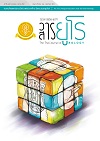Early experience of supine PCNL in Rajavithi Hospital
Keywords:
supine percutaneous nephrolithotomy, stone surface area, stone free rate, การผ่าตัดส่องกล้องเจาะกรอนิ่วในไตในท่านอนท่าหงาย, พื้นที่ผิวของนิ่ว, อัตราการหมดไปของนิ่วAbstract
Objective: Percutaneous nephrolithotomy (PCNL) is the standard treatment for kidney stones larger than 2 cm and usually performed in the prone position but this approach is uncomfortable for the patient and may cause circulatory and ventilatory difficulty. Recently the supine position is the new approach for PCNL and has several advantages include ease of patient positioning, more patient comfort and reduced cardio-circulatory or ventilatory dysfunction. We assess safety and efficacy of supine PCNL and modify this technique to our patient and would like to present initial clinical outcomes
Material and Methods: During August 2012 to January 2013, 11 patients underwent supine PCNL in Rajavithi hospital. The comorbidity included 1 severe scoliosis, 1 cardiac problem, 1 C-spondylolithiasis with paraplegia and 4 obesity (mean BMI was 33.8)
Results: The supine PCNL was performed in 11 patients (7 women, 4 men), 13 kidneys. Mean stone surface area was 789.76 mm2). Stone-free rate was 87.80 %. The mean postoperative hospital stay was 7 days without serious complication
Conclusion: The supine position for percutaneous nephrolithotomy is safe and effective option that offers several advantages with good outcome. It can be performed safely for deformed spine or morbidly obese patients and those with cardiopulmonary compromise
ประสบการณ์เริ่มแรกของโรงพยาบาลราชวิถีในการผ่าตัดส่องกล้องเจาะกรอนิ่วในไตในท่านอนหงาย
โคมทอง ปิตุจาตุรนต์, วรพจน์ ชุณหคล้าย
หน่วยศัลยกรรมยูโร, กลุ่มงานศัลยกรรม, โรงพยาบาลราชวิถี
บทคัดย่อ
วัตถุประสงค์: การผ่าตัดส่องกล้องเจาะกรอนิ่วในไต (percutaneous nephrolithotomy; PCNL) เป็นการรักษามาตรฐานของโรคนิ่วในไตที่มีขนาดมากกว่า 2 เซนติเมตร มักทำในท่านอนคว่ำ ซึ่งอาจประสบปัญหาในการจัดท่าและผ่าตัด ในผู้ป่วยที่มีปัญหาเกี่ยวกับระบบหัวใจและไหลเวียนโลหิต ระบบทางเดินหายใจ อ้วน กระดูกต้นคอหรือสันหลังผิดปกติ การศึกษานี้ มีวัตถุประสงค์เพื่อ ศึกษาประสิทธิภาพการรักษา ประโยชน์และความปลอดภัยของเทคนิคการผ่าตัดส่องกล้องเจาะกรอนิ่วในไตในท่านอนหงาย
วิธีการศึกษาและผู้ป่วย: รวบรวมข้อมูลผู้ป่วยโรคนิ่วในไต ที่ได้รับการรักษาด้วยการผ่าตัด PCNL ในท่านอนหงาย ตั้งแต่เดือนสิงหาคม พ.ศ. 2555 ถึง เดือนมกราคม พ.ศ. 2556 มีคนไข้จำนวนทั้งหมด 11 ราย พบผู้ป่วยที่มีปัญหา โรคอ้วน 4 ราย (ค่า BMI เฉลี่ย 33.8) โรคกระดูกสันหลังคด 1 ราย โรคกระดูกสันหลังส่วนคอเสื่อมร่วมกับการอ่อนแรงของขา1 ราย โรคหัวใจ 1 ราย
ผลการศึกษา: ผู้ป่วยที่ได้รับการผ่าตัดโดยวิธีผ่าตัดส่องกล้องเจาะกรอนิ่วในไตในท่านอนหงาย (supine PCNL) มีจำนวน11 ราย (ชาย 4 ราย, หญิง 7 ราย) มีจำนวนไตที่ได้รับการผ่าตัด 13 ข้าง ค่าเฉลี่ยพื้นที่ผิวของนิ่วก่อนผ่าตัด 789.76 ตารางมิลลิเมตร อัตราการหมดไปของนิ่ว (stone free rate) คิดเป็นร้อยละ 87.8 ระยะเวลานอนโรงพยาบาล 7 วันไม่พบภาวะแทรกซ้อนรุนแรง
สรุป: การผ่าตัดส่องกล้องเจาะกรอนิ่วในไตในท่านอนท่าหงายมีความปลอดภัย การจัดท่าผู้ป่วยทำได้ง่าย และมีประสิทธิภาพในการรักษานิ่วดี สามารถใช้แทนท่านอนคว่ำได้ และเหมาะสมสำหรับผู้ป่วยที่มีข้อห้ามหรือมีความเสี่ยงในการจัดท่านอนคว่ำ



